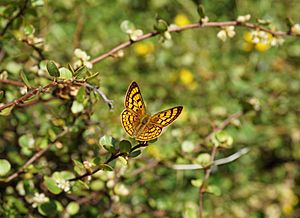Lycaena rauparaha facts for kids
Quick facts for kids Lycaena rauparaha |
|
|---|---|
 |
|
| Rauparaha's copper butterfly on Muehlenbeckia complexa | |
| Scientific classification | |
| Synonyms | |
|
The Lycaena rauparaha, also known as Rauparaha's copper or mokarakare, is a special type of butterfly. It lives only in New Zealand. This butterfly got its English name because it was found in the same coastal areas as Te Rauparaha. He was a famous chief and leader of the Ngāti Toa Māori tribe.
Contents
Where it Lives (Distribution)
You can find Rauparaha's copper butterflies along the western and northern coasts of New Zealand's North Island. They also live in the northern coastal areas of the South Island.
Its Home (Habitat)
These butterflies mostly live among the sand dunes near the coast. However, they can be found anywhere their special food plants grow.
Life Cycle of the Rauparaha's Copper
Eggs and Caterpillars
The female butterfly lays a single egg on the underside of a leaf. The caterpillars of the Rauparaha's copper butterfly mainly eat a plant called Muehlenbeckia complexa.
The caterpillars are a velvety green color. They have special flaps on their sides and ridges on their backs. These are common features for caterpillars in the Lycaena family.
Winter Sleep (Diapause)
When winter arrives and it gets colder, the small caterpillars go into a special "winter sleep." This is called diapause. They stop eating and growing during this time. When spring comes, they wake up and start feeding again. This winter sleep helps them survive when their food plants lose some leaves.
Pupae
After growing, the caterpillar changes into a pupa. The pupa is greenish-yellow with reddish-brown parts that will become wings. It attaches itself to a dead leaf on the ground. It uses a small hook-like part called a cremaster and a few silk threads to stay secure.
Adult Butterflies
Adult Rauparaha's copper butterflies fly very quickly. Their flight is jerky and stays close to the ground. These butterflies usually do not travel far from where their caterpillars eat. They typically stay within 20 to 50 meters of the Pohuehue plants. This means that their homes must have both the plants for their caterpillars and plants for the adult butterflies to feed on.

